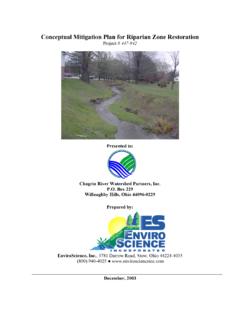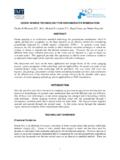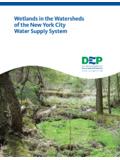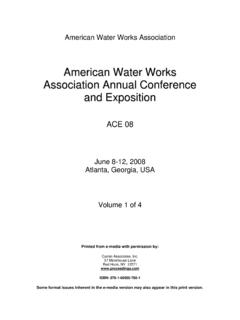Transcription of Floodplain Restoration and Storm Water …
1 Floodplain Restoration and Storm Water management : Guidance and Case Study Prepared by: Chagrin River Watershed Partners, Inc. Box 229 Willoughby, Ohio 44094 (440) 975-3870 (440) 975-3865 (fax) Biohabitats 2026 Murray Hill Road, Room 107 Cleveland, OH 44106 (fax) Floodplain Restoration and Storm Water management : Guidance and Case Study Page 2 Acknowledgements This report was prepared by the Chagrin River Watershed Partners, Inc. (CRWP) under award LEPF 05 -12 from the Lake Erie Protection Fund, with funding made possible by the sale of the Lake Erie Number Plates. The statements, findings, conclusions and recommendations are those of the author(s) and do not necessarily reflect the views of the Ohio Lake Erie Commission.
2 Additional support for this report was provided by the Members of CRWP through their annual Member dues. CRWP is a non-profit technical organization formed by the townships, villages, cities, counties, and park districts of the Chagrin watershed to develop and implement innovative solutions to address current, and minimize new, flooding, erosion, and Water quality costs and to control the increasing infrastructure costs associated with urban/suburban development. CRWP provides Members with advice and assistance on zoning and subdivision codes, implementation of these codes, development plan review, and other best practice implementation at Member direction. Cover Photographs. Top Left: Floodplain Restoration in Germany (Photo by: Unknown from internet website) Top Right: Ditch Improvement (Photo by: Amy Holtshouse Brennan) Bottom Left: Daniels Park (Photo by: Amy Holtshouse Brennan) Bottom Right: Chagrin River in Waite Hill (Photo by: Brian Sherwin) Floodplain Restoration and Storm Water management .
3 Guidance and Case Study Page 3 TABLE OF CONTENTS Introduction to Floodplain Restoration 4 Storm Water management Benefits Associated with Floodplains 9 Floodplain Restoration as a Storm Water Practice 11 Floodplain Restoration Tools 12 LIST OF FIGURES Figure 1 Examples of Disconnected Floodplains 4 Figure 2 Examples of Riparian Buffer Enhancement 5 Figure 3 Floodplain Re-vegetation 5 Figure 4 A Stream Restoration Project 5 Figure 5 Examples of a Degraded Stream 6 Figure 6 A Restoration Before and After
4 6 Figure 7 A Floodplain Restoration Project 7 Figure 8 Cross-section of Floodplain Restoration 8 Figure 9 Schematic of a Reforested Floodplain 16 Figure 10 Cross-section of Reforestation to a Subdivision 17 Figure 11 Detail of Floodplain Benching 22 Figure 12 Cross-section of Floodplain Benching and Bankfull Channel Restoration 23 Figure 13 Profile of a Regenerative Storm Conveyance Project 24 Figure 14 A Regenerative Storm Water Conveyance Project 25 Figure 15 Another Regenerative Storm Water Conveyance Project 26 Figure 16 A Before and After of a Regenerative Storm Water Conveyance Project 27 LIST OF APPENDIXES Appendix 1 Case Studies 30 Floodplain Restoration and Storm Water management .
5 Guidance and Case Study Page 4 Introduction to Floodplain Restoration A Floodplain is a flat or nearly flat lowland bordering a stream or river that experiences occasional or periodic flooding. It includes the floodway, which consists of the stream channel and adjacent areas that carry flood flows, and the flood fringe, which are areas covered by the flood, but which do not experience a strong current. The Floodplain corridor acts as the right-of-way for a stream and functions as an integral part of the stream ecosystem. Floodplains perform important natural functions, including temporary storage of floodwaters, moderation of peak flows, maintenance of Water quality, groundwater recharge, and prevention of erosion. Floodplains also provide habitat for wildlife, recreational opportunities, and aesthetic benefits.
6 Ideal Floodplain conditions are rarely encountered in urban or disturbed watersheds; many Floodplain functions have been lost to agricultural uses and more recently to urban and suburban development (Figure 1). Floodplain Restoration is the process of fully or partially restoring a stream s access to its Floodplain to return those valuable Floodplain functions. There are multiple types of Floodplain Restoration : Hydrologic. Reconnecting the stream to the Floodplain and restoring the stream s natural hydrology. Vegetative. Removing invasive species and replanting native plant communities appropriate to the site and conditions. Habitat Restoration . Installing structures to improve wildlife habitat. Habitat is also gained through re-planting native plant communities.
7 Several examples of restored and reconnected floodplains are displayed in Figures 2 through 8. Figure 1: These are two examples of streams that have been disconnected from their floodplains. On the left, upstream development has increased stream flows, resulting in channel erosion and downcutting. The entrenched stream no longer overflows onto its Floodplain . On the right, the Floodplain was filled in and raised during development, cutting off the stream s access to its Floodplain . Floodplain Restoration and Storm Water management : Guidance and Case Study Page 5 Figure 2: Examples of riparian buffer enhancement. In both cases, additional riparian trees and shrubs have been planted to expand the width of the forested buffer. Figure 3: Floodplain re-vegetation, before (left) and after (right).
8 Figure 4: A stream Restoration project with Floodplain benching. On both sides of the restored stream, a bench has been graded at the bankfull elevation, providing room to dissipate high flow events and opportunities for riparian habitat creation. Floodplain Restoration and Storm Water management : Guidance and Case Study Page 6 Figure 5: Severely down-cut banks (left) and compromised riparian vegetation before Restoration ensued. Now restored, the stream is a stable, functioning system, reconnected to its floodplains (right). Figure 6: A severely eroded bank caused in part by agricultural activities (left) was restored by regrading the streambank, installing rock grade-control structures (to prevent bed degradation), and establishing riparian buffer (right).
9 Floodplain Restoration and Storm Water management : Guidance and Case Study Page 7 Figure 7: Evolution of a stream and Floodplain Restoration project. Floodplain Restoration and Storm Water management : Guidance and Case Study Page 8 Biohabitats, 8: Conceptual cross section of Floodplain Restoration . The existing grade (dashed line) is lowered along the channel and different levels of Floodplain are created, providing opportunities for different hydrologic regimes and resulting vegetative communities. Floodplain Restoration and Storm Water management : Guidance and Case Study Page 9 Storm Water management Benefits Associated with Floodplains Floodplains offer a large array of economic, ecological, and sociological benefits to communities.
10 Floodplains can provide flood control, erosion control, Storm Water management and Water quality services. In urban and suburban settings, it can be challenging to balance these benefits with the need for public living spaces and services. Often, engineered solutions to Storm Water management are pursued that allow for increased development intensity and density adjacent to streams, floodplains, and wetlands. Unfortunately, these expensive structural solutions can have limited effectiveness, can exacerbate undesirable conditions, and may simply transfer a problem to another location. For example, development adds rooftops, driveways, sidewalks, parking lots and roadways to the landscape. These hard surfaces, or impervious surfaces, prevent infiltration of Storm Water into the ground and produce greater volumes of Storm Water runoff.





